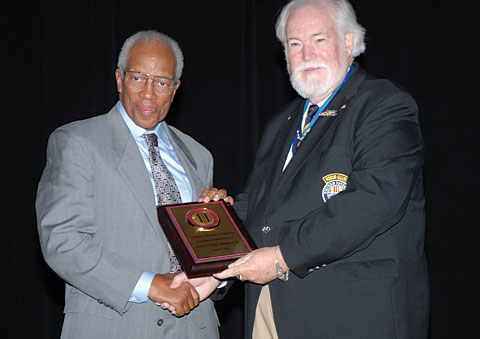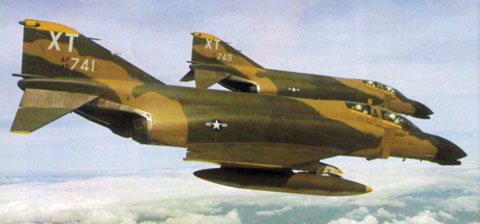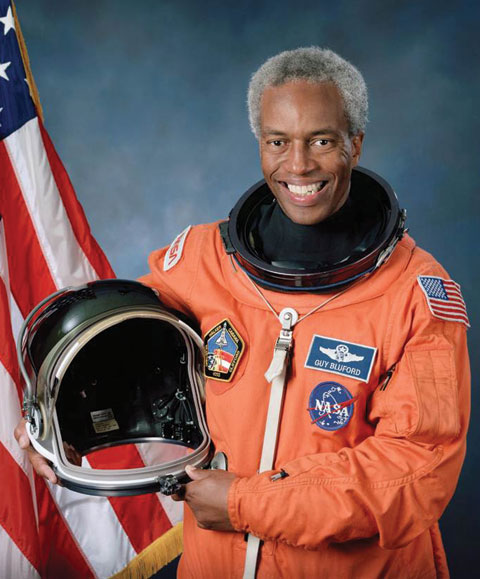 |
||||||||||||
|
September/October 2013
Guy Bluford: Fighter Pilot, Astronaut, Aeronautic Consultant BY WILLIAM C. TRIPLETT
“I greatly enjoy my world,” he says. “I can pick what I want to do now.” Nice work if you can get it. Bluford got it the way most overachievers do: earning it multiple times. Bluford never thought he’d be a pilot, even when he was part of the Air Force ROTC program at Penn State University in the early 1960s. “I planned to be an aerospace engineer,” he says. After graduating from PSU with honors in 1964, he figured on serving in the Air Force as an engineer. But he made a last-minute decision to become a pilot, which set him on a course he could not even have imagined. Pinning on his wings in January 1966, Bluford received his first assignment: flying F-4 Phantoms with the 433rd Tactical Fighter Squadron based in Thailand. Before deployment he underwent nine months of training for combat crew operations in F-4Cs, followed by jungle survival school. Then his orders were changed from Thailand to Cam Ranh Bay, to serve with the 557th Tactical Fighter Squadron. He arrived in October 1966. During the next nine months he flew 144 combat missions, 65 over North Vietnam. The routine was established pretty quickly. “You’d wake up, head over to squadron operations, and see if you were flying that day,” Bluford recalls. “If so, you had to be ready two hours before the mission for the briefing.”
The missions varied—bombing runs over many parts of South Vietnam right up to the DMZ; providing air cover over Haiphong and Hanoi in the North; interdicting supply routes in Laos; supporting Army ground operations. “I really enjoyed the in-country air-to-ground support missions,” Bluford says. Pulling alert duty, however, was his favorite. “For two days you’d live out on the alert pad by the end of the runway, and when the alarm went off, you jumped in your aircraft and went,” he says. “Those were the best.” Though it was a rotating duty, Bluford spent more than his share of time on alert. “I’m not a drinker, so whenever it was a holiday, I was usually on the alert pad because I was the only pilot sober.” He didn’t mind because “the F-4 was just great fun to fly.”
“We lost a few,” Bluford says. “We lost one guy over the DMZ, and he ended up a POW for six or seven years. Another guy was killed during a napalm run north of Saigon.” The 557th almost lost Bluford during a mission over North Vietnam, when an 85mm antiaircraft gun opened up on his aircraft. “They didn’t shoot at anyone else in the flight of four,” he says. But, although they shot at him repeatedly, Bluford managed to escape unharmed.
But he thinks the exercise was limited. Second impression: “We did not effectively use air power to prosecute the war. There were a lot of things we couldn’t do,” Bluford says. “I think in the end I left with the same feeling that a lot of guys who led the [1991 U.S. and allied] attack on Kuwait had: If you’re going to use military power, you’ve got to use it all. There’s no half way.” Among the decorations he received were the Vietnam Cross of Gallantry with Palm and ten Air Force Air Medals. In 1967 Bluford found no lack of Air Force pilot jobs available stateside, because most of his colleagues were heading to Vietnam. He took a position as an instructor pilot at Sheppard Air Force Base in Texas, teaching new pilots to fly T-38 trainers. He stayed almost five years and attended Squadron Officers School to become executive support officer to the Deputy Commander of Operations. Bluford never lost his interest in engineering. He eventually applied for a scholarship program at the Air Force Institute of Technology, earning both an M.S. and Ph.D. “About then I came up for reassignment,” Bluford remembers, “and the Air Force wanted me back in a cockpit. I said I’d fly fighters again, and they said no way.”
Bluford was aware of the new space program that NASA was about to launch, the shuttle, and thought it might be time to leave the Air Force since he wasn’t doing what he really wanted to do. “The shuttle was just coming off the assembly line,” he says. “NASA was hiring. I thought about it a long time, and I didn’t think I’d make it, but then”—for the second fateful time—“I applied at the last minute.” About eight thousand other people applied, too. Bluford was selected for a week of intensive interviews by NASA officials at Johnson Space Center in Houston in 1977. In January 1978 the space agency announced that he was one of the thirty-five first astronauts chosen for the shuttle program. Two other African Americans and six women—including Sally Ride—were among the new recruits.
NASA next assigned Bluford to a crew to fly on a Challenger mission slated for launch in January 1986. The crew that ultimately died in the explosion minutes after that launch had originally been assigned to fly in October 1985. But as October had approached, “that crew was having problems and wasn’t ready to go,” he says. “Our crew was ready, even though we weren’t going to launch until January. So they flipped us: We went up in October, and they were put into the January slot.” “It was very upsetting,” Bluford says of the accident. “Some astronauts left the program because their wives were scared. I made a commitment to stay because I lost some good friends in that accident and I wanted to do whatever I could to help make sure the shuttle would fly again.” Shuttle crews had established a tradition involving symbolic keys that had been made for each shuttle. After a crew returned from a mission, they handed off the keys for that particular shuttle to the next crew scheduled to go up in it. In October 1985 Bluford was aboard the Challenger—its last successful flight. “I was going to give the Challenger keys [to the January 1986 crew] but never managed to do it in time,” he says. For the rest of his tenure at NASA—about ten years—Bluford kept these keys on a wall in his office. Bluford flew four shuttle missions, logging 688 hours in space and performing a wide variety of scientific tasks. He loved it all, he says, especially launches and the feeling of zero gravity. “But being an astronaut is like eating chocolate cake,” he observes. “No matter how much you like it, you’ve got to eat something else eventually.” After receiving an M.B.A. while still with NASA, Bluford left the Astronaut Corps in 1993 to go work in the aerospace industry. In 2002 he founded the Aerospace Technology Group, an engineering consulting organization in Cleveland. Among his first clients: The independent board convened to investigate the loss of the shuttle Columbia, which broke apart during reentry in 2003, killing the crew. Because of his technological and scientific expertise, Bluford consulted on the investigation. It wasn’t easy. While still immensely proud of his time with NASA and of the agency’s overall work, “I was pissed at NASA because they had made the same mistake twice—normalization of deviation,” he says. As had been the case with the Challenger accident, “they had seen something out of the ordinary and came to accept it, and it killed people.”
|
||||||||||||
|
|
||||||||||||
8719 Colesville Road, Suite 100, Silver Spring. MD 20910 | www.vva.org | contact us |
||||||||||||











.jpg) Bluford’s time in Vietnam made two deep impressions on him. “I saw how the Air Force worked, how to fly and fight,” he says. “It was very educational to see how the Air Force exercised air power. That was good.”
Bluford’s time in Vietnam made two deep impressions on him. “I saw how the Air Force worked, how to fly and fight,” he says. “It was very educational to see how the Air Force exercised air power. That was good.” In 1983, as part of the crew for shuttle Challenger’s third flight, he became the first African American to go into space. Bluford knew it would be more than just another NASA mission. “I think I recognized the historical significance of what I was doing, and I wanted to do as good a job as possible,” he says. The mission included deploying a satellite, operating the shuttle’s robotic arm, and taking medical measurements to better understand the biophysiological effects of space flight. NASA deemed the mission a complete success.
In 1983, as part of the crew for shuttle Challenger’s third flight, he became the first African American to go into space. Bluford knew it would be more than just another NASA mission. “I think I recognized the historical significance of what I was doing, and I wanted to do as good a job as possible,” he says. The mission included deploying a satellite, operating the shuttle’s robotic arm, and taking medical measurements to better understand the biophysiological effects of space flight. NASA deemed the mission a complete success.